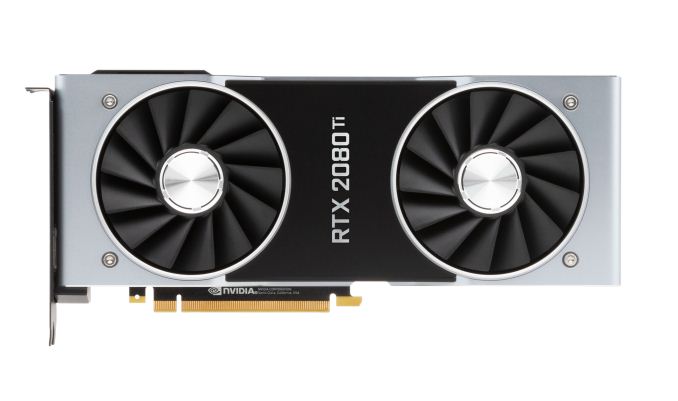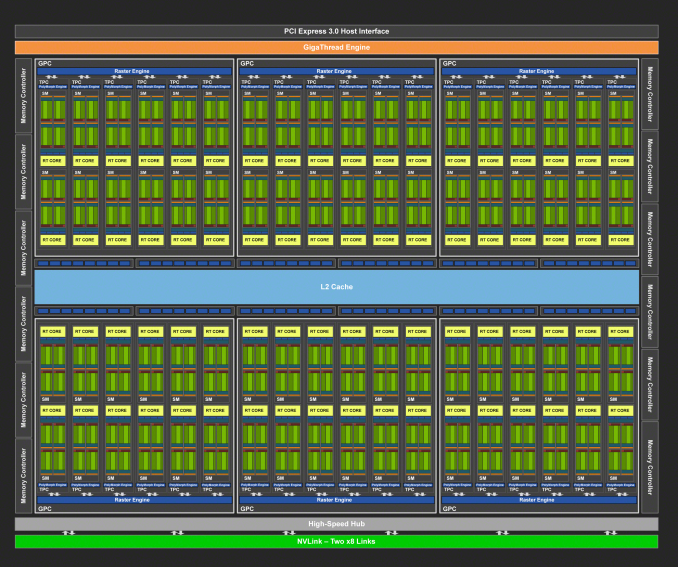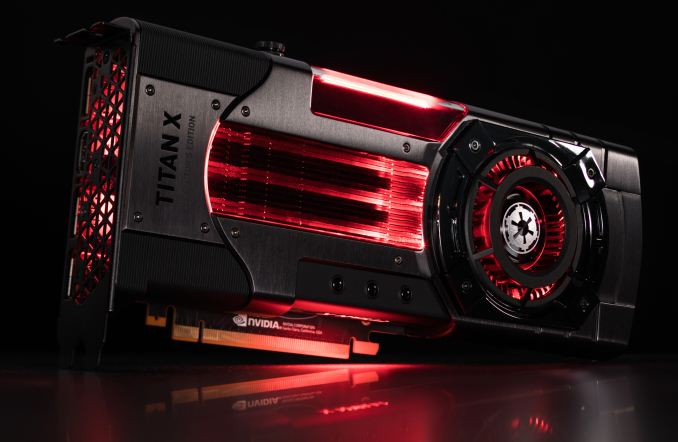The NVIDIA GeForce RTX 2080 Ti & RTX 2080 Founders Edition Review: Foundations For A Ray Traced Future
by Nate Oh on September 19, 2018 5:15 PM EST- Posted in
- GPUs
- Raytrace
- GeForce
- NVIDIA
- DirectX Raytracing
- Turing
- GeForce RTX

While it was roughly 2 years from Maxwell 2 to Pascal, the journey to Turing has felt much longer despite a similar 2 year gap. There’s some truth to the feeling: looking at the past couple years, there’s been basically every other possible development in the GPU space except next-generation gaming video cards, like Intel’s planned return to discrete graphics, NVIDIA’s Volta, and cryptomining-specific cards. Finally, at Gamescom 2018, NVIDIA announced the GeForce RTX 20 series, built on TSMC’s 12nm “FFN” process and powered by the Turing GPU architecture. Launching today with full general availability is just the GeForce RTX 2080, as the GeForce RTX 2080 Ti was delayed a week to the 27th, while the GeForce RTX 2070 is due in October. So up for review today is the GeForce RTX 2080 Ti and GeForce RTX 2080.
But a standard new generation of gaming GPUs this is not. The “GeForce RTX” brand, ousting the long-lived “GeForce GTX” moniker in favor of their announced “RTX technology” for real time ray tracing, aptly underlines NVIDIA’s new vision for the video card future. Like we saw last Friday, Turing and the GeForce RTX 20 series are designed around a set of specialized low-level hardware features and an intertwined ecosystem of supporting software currently in development. The central goal is a long-held dream of computer graphics researchers and engineers alike – real time ray tracing – and NVIDIA is aiming to bring that to gamers with their new cards, and willing to break some traditions on the way.
| NVIDIA GeForce Specification Comparison | ||||||
| RTX 2080 Ti | RTX 2080 | RTX 2070 | GTX 1080 | |||
| CUDA Cores | 4352 | 2944 | 2304 | 2560 | ||
| Core Clock | 1350MHz | 1515MHz | 1410MHz | 1607MHz | ||
| Boost Clock | 1545MHz FE: 1635MHz |
1710MHz FE: 1800MHz |
1620MHz FE: 1710MHz |
1733MHz | ||
| Memory Clock | 14Gbps GDDR6 | 14Gbps GDDR6 | 14Gbps GDDR6 | 10Gbps GDDR5X | ||
| Memory Bus Width | 352-bit | 256-bit | 256-bit | 256-bit | ||
| VRAM | 11GB | 8GB | 8GB | 8GB | ||
| Single Precision Perf. | 13.4 TFLOPs | 10.1 TFLOPs | 7.5 TFLOPs | 8.9 TFLOPs | ||
| Tensor Perf. (INT4) | 430TOPs | 322TOPs | 238TOPs | N/A | ||
| Ray Perf. | 10 GRays/s | 8 GRays/s | 6 GRays/s | N/A | ||
| "RTX-OPS" | 78T | 60T | 45T | N/A | ||
| TDP | 250W FE: 260W |
215W FE: 225W |
175W FE: 185W |
180W | ||
| GPU | TU102 | TU104 | TU106 | GP104 | ||
| Transistor Count | 18.6B | 13.6B | 10.8B | 7.2B | ||
| Architecture | Turing | Turing | Turing | Pascal | ||
| Manufacturing Process | TSMC 12nm "FFN" | TSMC 12nm "FFN" | TSMC 12nm "FFN" | TSMC 16nm | ||
| Launch Date | 09/27/2018 | 09/20/2018 | 10/2018 | 05/27/2016 | ||
| Launch Price | MSRP: $999 Founders $1199 |
MSRP: $699 Founders $799 |
MSRP: $499 Founders $599 |
MSRP: $599 Founders $699 |
||
As we discussed at the announcement, one of the major breaks is that NVIDIA is introducing GeForce RTX as the full upper tier stack with x80 Ti/x80/x70 stack, where it has previously tended towards the x80/x70 products first, and the x80 Ti as a mid-cycle refresh or competitive response. More intriguingly, each GeForce card has their own distinct GPU (TU102, TU104, and TU106), with direct Quadro and now Tesla variants of TU102 and TU104. While we covered the Turing architecture in the preceding article, the takeaway is that each chip is proportionally cut-down, including the specialized RT Cores and Tensor Cores; with clockspeeds roughly the same as Pascal, architectural changes and efficiency enhancements will be largely responsible for performance gains, along with the greater bandwidth of 14Gbps GDDR6.
And as far as we know, Turing technically did not trickle down from a bigger compute chip a la GP100, though at the architectural level it is strikingly similar to Volta/GV100. Die size brings more color to the story, because with TU106 at 454mm2, the smallest of the bunch is frankly humungous for a FinFET die nominally dedicated for a x70 GeForce product, and comparable in size to the 471mm2 GP102 inside the GTX 1080 Ti and Pascal Titans. Even excluding the cost and size of enabled RT Cores and Tensor Cores, a slab of FinFET silicon that large is unlikely to be packaged and priced like the popular $330 GTX 970 and still provide the margins NVIDIA is pursuing.
These observations are not so much to be pedantic, but more so to sketch out GeForce Turing’s positioning in relation to Pascal. Having separate GPUs for each model is the most expensive approach in terms of research and development, testing, validation, extra needed fab tooling/capacity – the list goes on. And it raises interesting questions on the matter of binning, yields, and salvage parts. Though NVIDIA certainly has the spare funds to go this route, there’s surely a better explanation than Turing being primarily designed for a premium-priced consumer product that cannot command the margins of professional parts. These all point to the known Turing GPUs as oriented for lower-volume, and NVIDIA’s financial quarterly reports indicate that GeForce product volume is a significant factor, not just ASP.
And on that note, the ‘reference’ Founders Edition models are no longer reference; the GeForce RTX 2080 Ti, 2080, and 2070 Founders Editions feature 90MHz factory overclocks and 10W higher TDP, and NVIDIA does not plan to productize a reference card themselves. But arguably the biggest change is the move from blower-style coolers with a radial fan to an open air cooler with dual axial fans. The switch in design improves cooling capacity and lowers noise, but with the drawback that the card can no longer guarantee that it can cool itself. Because the open air design re-circulates the hot air back into the chassis, it is ultimately up to the chassis to properly exhaust the heat. In contrast, a blower pushes all the hot air through the back of the card and directly out of the case, regardless of the chassis airflow or case fans.
All-in-all, NVIDIA is keeping the Founders Edition premium, which is now $200 over the baseline ‘reference.’ Though AIB partner cards are also launching today, in practice the Founders Edition pricing is effectively the retail price until the launch rush has subsided.
The GeForce RTX 20 Series Competition: The GeForce GTX 10 Series
In the end, the preceding GeForce GTX 10 series ended up occupying an odd spot in the competitive landscape. After its arrival in mid-2016, only the lower end of the stack had direct competition, due to AMD’s solely mainstream/entry Polaris-based Radeon RX 400 series. AMD’s RX 500 series refresh in April 2017 didn’t fundamentally change that, and it was only until August 2017 that the higher-end Pascal parts had direct competition with their generational equal in RX Vega. But by that time, the GTX 1080 Ti (not to mention the Pascal Titans) was unchallenged. And all the while, an Ethereum-led resurgence of mining cryptocurrency on video cards was wreaking havoc on GPU pricing and inventory, first on Polaris products, then general mainstream parts, and finally affecting any and all GPUs.
Not that NVIDIA sat on their laurels with Vega, releasing the GTX 1070 Ti anyhow. But what was constant was how the pricing models evolved with the Founders Editions schema, the $1200 Titan X (Pascal), and then $700 GTX 1080 Ti and $1200 Titan Xp. Even the $3000 Titan V maintained gaming cred despite diverging greatly from previous Titan cards as firmly on the professional side of prosumer, basically allowing the product to capture both prosumers and price-no-object enthusiasts. Ultimately, these instances coincided with the rampant cryptomining price inflation and was mostly subsumed by it.
So the higher end of gaming video cards has been Pascal competing with itself and moving up the price brackets. For Turing, the GTX 1080 Ti has become the closest competitor. RX Vega performance hasn’t fundamentally changed, and the fallout appears to have snuffed out any Vega 10 parts, as well as Vega 14nm+ (i.e. 12nm) refreshes. As a competitive response, AMD doesn’t have many cards up their sleeves except the ones already played – game bundles (such as the current “Raise the Game” promotion), FreeSync/FreeSync 2, other hardware (CPU, APU, motherboard) bundles. Other than that, there’s a DXR driver in the works and a machine learning 7nm Vega on the horizon, but not much else is known, such as mobile discrete Vega. For AMD graphics cards on shelves right now, RX Vega is still hampered by high prices and low inventory/selection, remnants of cryptomining.
For the GeForce RTX 2080 Ti and 2080, NVIDIA would like to sell you the RTX cards as your next upgrade regardless of what card you may have now, essentially because no other card can do what Turing’s features enable: real time raytracing effects ((and applied deep learning) in games. And because real time ray tracing offers graphical realism beyond what rasterization can muster, it’s not comparable to an older but still performant card. Unfortunately, none of those games have support for Turing’s features today, and may not for some time. Of course, NVIDIA maintains that the cards will provide expected top-tier performance in traditional gaming. Either way, while Founders Editions are fixed at their premium MSRP, custom cards are unsurprisingly listed at those same Founders Edition price points or higher.
| Fall 2018 GPU Pricing Comparison | |||||
| AMD | Price | NVIDIA | |||
| $1199 | GeForce RTX 2080 Ti | ||||
| $799 | GeForce RTX 2080 | ||||
| $709 | GeForce GTX 1080 Ti | ||||
| Radeon RX Vega 64 | $569 | ||||
| Radeon RX Vega 56 | $489 | GeForce GTX 1080 | |||
| $449 | GeForce GTX 1070 Ti | ||||
| $399 | GeForce GTX 1070 | ||||
| Radeon RX 580 (8GB) | $269/$279 | GeForce GTX 1060 6GB (1280 cores) |
|||













337 Comments
View All Comments
godrilla - Wednesday, September 19, 2018 - link
Conclusions*BurntMyBacon - Thursday, September 20, 2018 - link
I'm going to take a (admittedly small) leap of faith and suggest that nVidia most likely is not intentionally limiting performance of Turing cards. Given the amount of hardware dedicated to tasks that don't benefit rasterization, it just doesn't seem like could have left that much performance on the table. It is much more likely that they've simply got prices set high with the intent of dropping them once high end pascal inventory clears out. Of course, after the mining push, they've seen how much the market is willing to bear. They may be trying to establish a new pricing structure that gives the extra profits to them rather than retailers.mapesdhs - Wednesday, September 26, 2018 - link
Give the amount of deceitful PR being used for this launch, I don't think your leap is justified.tamalero - Wednesday, September 19, 2018 - link
I honestly believe the endgame of Nvidia is simple. They want to increase their margin, and the only way to to that is to sell the WHOLE full chips, tensor and all to gamers. While still charging top notch to Pros.This would lead Nvidia to make LESS variants, saving costs in having to design multiple versions when they cant scale down or cut.
PopinFRESH007 - Wednesday, September 19, 2018 - link
your argument is invalidated by the evidence of this product launch. All three cards are on different chips.eva02langley - Thursday, September 20, 2018 - link
You are kidding me? This is exactly this. They made an all around chip to tackle pros, gamers and compute. Vega has the same issue. It was aimed at being an iGPU to a dGPU. It does extremely well at low input, but as a dGPU.They save cost and standardize their manufacturing process. It is nothing else.
Bensam123 - Wednesday, September 19, 2018 - link
Going to go a weird direction with this. I believe cards are going to start diverging from one another in terms of what gamers are looking for. Hardcore gamers that are after the professional scene and absolute performance always turn graphics down, they drive high refresh rate monitor, with low response times, and high frame rates to absolutely limit the amount of variance (spiking) that is present in their gaming experience.Nvidia went for absolute fidelity where they believe the best gaming experience will come from picture perfect representations of an environment, such as with ray tracing. I see ray tracing as a gamer and I go 'Welp that's something I'll turn off'. Hardware review websites are only looking at gaming from a cinematic standpoint, where best gaming will always have everything maxed out running at 8k. Cards do perform differently under different resolutions and especially with different amounts of eye candy turned on. I really think Anand should look into testing cards at 1080p on lowest settings with everything uncapped - Not as the only datapoint, but as another one. Professional gamers or anyone who takes gaming seriously will be running that route.
Which runs into another scenario, where card makers are going to diverge. AMDs upcomming 7nm version of Vega for instance may continue down Vegas current path, which means they'll be focusing on current day performance (although they mentioned concentrating more on compute we can assume the two will intersect). That means while a 2080ti might be faster running 4k@ultra, especially with rays if that ever takes off, it may lose out completely at 1080p@low (but not eyecancer, such as turning down resolution or textures).
For testing at absolute bleeding speeds, that 1% that is removed in 99% percentile testing really starts to matter. Mainly because the spikes, the micro-stutters, the extra long hiccups get you killed and that pisses off gamers that aim for the pinnacle. Those might seem like outliers, but if they happen frequently-infrequently enough, they are part of a distribution and shouldn't be removed. When aiming for bleeding speeds, they actually matter a lot more.
So thus is born the esports gaming card and the cinematic gaming card. Please test both.
PopinFRESH007 - Wednesday, September 19, 2018 - link
so they should include the horizontal line of a completely CPU bound test? Also I'm not understanding the statistical suggestions, they make no sense. Using the 99th percentile is very high already and the minuscule amount of outliers being dropped are often not due to the GPU. As long as they are using the same metric for all tests in the data set it is irrelevant.Bensam123 - Thursday, September 20, 2018 - link
Not all games are CPU bound, furthermore it wouldn't be completely horizontal, that would imply zero outliers, which never happens. In the case of that instead of looking at 99% frame time you would instead focus on the other part 1% frame time or all the stuttering and microstutters. You can have a confidence in tail ends of a distribution if there is enough data points.Also having played tons of games on low settings, you are 100% incorrect about it being a flat line. Go play something like Overwatch or Fortnite on low, you don't automagically end up at CPU cap.
V900 - Thursday, September 20, 2018 - link
Despite all the (AMD) fanboy rage about higher prices, here’s what will happen:Early adopters and anyone who wants the fastest card on the market, will get an RTX 2080/2070, Nvidia is going to make a tidy profit, and in 6-12 months prices will have dropped and cheaper Turing cards will hit the market.
That’s when people with a graphics card budget smaller than 600$ will get one. (AMD fanboys will keep raging though, prob about something else that’s also Nvidia related.)
That’s how it always works out when a new generation of graphics hit the market.
But everyone who’s salty about “only” getting a 40% faster card for a higher price won’t enjoy the rest of the decade.
There won’t be anymore GPUs that deliver a 70-80% performance increase. Not from AMD and not from Nvidia.
We’re hitting the limits of Moore’s law now, so from here on out, a performance increase of 30% or less on a new GPU will be the standard.